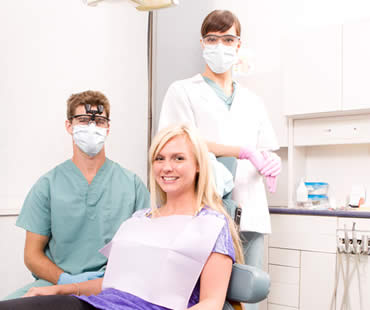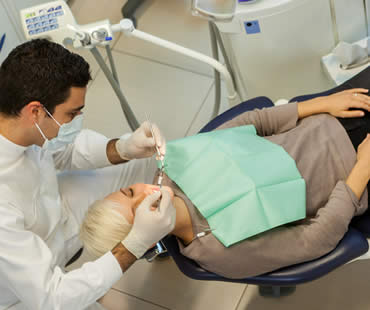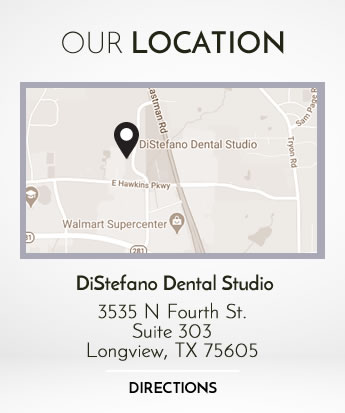
If you are either planning to undergo cosmetic dental procedures or necessary treatments for dental problems, there is a case to be made for considering sedation dentistry. Sedation dentistry refers to the use of medications in varying forms to calm and relax you prior to and during a dental procedure. Just a few reasons to consider dental sedation include:
- Dental sedation can be used for essentially all regular dental procedures. Under sedation, your dentist can accomplish far more in one appointment, meaning less overall time for you in the dental chair. Procedures that may normally take 2 or 3 visits to the dentist can be completed all in one visit with the help of dental sedation.
- Normally, dentists do not like to work on both sides of the mouth at the same time as this requires anesthesia to each side and could cause the patient to bite their tongue. Sedation dentistry allows your dentist to work on both sides of the mouth in one sitting.
- Dental sedation allows you to feel relaxed and free from stress while the actual procedure is being performed. In many cases, even though you are still conscious, you will not remember any of the actual time you spent in the dentist chair.
With sedation dentistry, there is no need to dread dental treatments and procedures. Your fears and anxiety should not deter you from seeking the cosmetic or restorative dental care that you desire. Consult with your dental professional about the options offered for sedation, and schedule your oral care with the confidence that you will have a calm and pleasant experience while improving your smile.
Our dental office is located in Longview

Many types of cosmetic dentistry procedures such as crowns, bridges, tooth implants, or other invasive procedures require some kind of anesthesia in order to be performed in comfort for the patient. Even a procedure like porcelain dental veneers can be aided by the addition of some kind of sedation dentistry, especially if the patient is experiencing anxiety or fear regarding the treatment. For any patient seeking a more relaxed cosmetic dental experience, sedation dentistry presents several options.
Inhaled sedation, or nitrous oxide, is more commonly known as “laughing gas.” It is inhaled via a mask and is controlled by your dentist. It is a light sedation, and allows you to remain completely responsive and compliant to instruction. Nitrous oxide sedation wears off quickly; because of this, you may be able to drive yourself home after your treatment.
Conscious oral sedation reduces your anxiety while still allowing for responsiveness to requests and directions. Oral sedatives are typically prescribed in pill form, and can be taken up to an hour before your dental procedure. Some dentists believe that taking a mild oral sedative the night before treatment can alleviate anxiety and ensure proper rest. You should not drive yourself home if you have taken an oral sedative for your dental treatment. You will not be fully alert.
IV sedation is also known as “sleep dentistry.” It provides the most relaxed dental experience, allowing you to be deeply sedated while never completely unconscious. A natural effect of the drugs is full or partial memory loss of the time during its use, so you may have no memories of your procedure. You should never drive following IV sedation, and you may not be fully alert for several hours. Plan to go home, rest, and sleep.
Your cosmetic dentist wants you to be comfortable throughout your dental therapy and will know which sedation dentistry option is right for your particular cosmetic dentistry procedure. Talk to your cosmetic dentist today about any concerns you have regarding your treatment so that you may have the most positive, pain and anxiety-free experience possible.
We look forward to seeing you in our Longview dental office

Once you and your dental professional have agreed on conscious dental sedation for use during your dental treatment, there are a variety of ways in which it can be administered.
Inhalation sedation or the use of nitrous oxide (laughing gas) is a light form of conscious sedation. Your sedation dentist will administer a combination of nitrous oxide and oxygen through a mask that is placed over your nose. During the procedure, you inhale the gas through your nose and back out through your mouth. Nitrous oxide wears off almost immediately upon completion of the procedure with minimal to no recovery time or side effects.
Oral medication used for sedation purposes produces medium or moderate sedation effects, depending on the strength of the prescription administered by your sedation dentist. Oral sedation usually comes in pill form and is taken approximately one hour prior to the procedure. You may feel sleepy, but should still be able to respond to your dentist’s commands. Recovery time is longer with oral sedation, and requires someone to drive you home. Side effects are rare, but may include nausea or vomiting.
Another moderate form of conscious sedation is intravenous (IV) sedation. In the case of IV sedation, the drugs are administered directly into your veins through a needle. The effects of IV sedation are much quicker than oral sedation. IV sedation allows your dental professional to adjust the levels of sedation during treatment. With IV sedation, you may begin to feel alert soon after the medication has stopped; however, you should not drive or operate heavy machinery for at least 24 hours after the procedure.
Conscious sedation should only be performed by a dental professional with appropriate training. Your sedation dentist will consider your health history when choosing the appropriate form of sedation to best suit your needs. While conscious sedation is considered safe, it is best to work with a qualified sedation dentist to determine the best form of administration for your dental treatment.
If you need a dentist in Longview contact us today

Sedation dentistry provides a way for those who experience anxiety or fear about visiting the dentist to get the treatment they need. It is also helping in relieving pain, and enabling more dental work to be performed in one visit. Two common methods of administering sedation are oral and intravenous (IV). Each type has its own unique characteristics and attributes.
Oral sedation involves swallowing pills or liquids. There are no shots, which is good news for patients afraid of needles. However, oral sedatives are less predictable because each medication affects people differently based on age, weight, medical history, and more. Also, there is a time delay between swallowing it and taking effect. Since the medication is absorbed through digestion, it is difficult to alter the sedation level quickly during treatment. Nearly all patients respond well to oral sedation, with few occurrences of any side effects. Patients typically don’t remember anything that occurred during treatment.
IV sedation means that the medication goes directly into the blood stream though an IV injection. A very powerful method, the effects are instant once the shot is given. If the medication begins to wear off, more can be administered through the IV for immediate results. IV sedation is very common during oral surgeries, which benefit from the ability to alter the medication dosage as needed. It is advantageous for long procedures or when multiple treatments are being done in one sitting. Patients will not remember the procedure or sometimes even the appointment at all. The biggest drawback of IV sedation is for patients who dislike needles. IV sedation requires that the dentist have special training and certification, so make sure that your dentist is qualified if this method is offered.
Both types of sedation can be effective depending on the situation and patient. Discuss your case with your dentist to help you decide which one might be the best for you.
We look forward to seeing you in our Longview dental office

Sedation dentistry is rapidly becoming an extremely popular choice for patients, offering them the best oral care available while providing them with a comfortable, stress-free experience. Benefits exist for both the patient and the dentist, especially for certain patient groups, who may only be able to obtain dental care they need while under some kind of sedation.
Sedation dentistry uses various medications to help the patient relax while undergoing a dental procedure. The sedation allows the patient to be free of fear, anxiety and stress, and in some cases, to have a reduced memory of the treatment itself. This allows for a much more favorable experience, especially when undergoing invasive, extensive or multiple-visit treatments such as extractions, gum surgery, root canals, or some cosmetic dentistry procedures.
Because sedation dentistry is specifically designed to reduce or to alleviate fear and anxiety, the patient is more relaxed during the dental visit. Dentists working on tense or anxious patients are often aware of the problem and have to work with greater care. The removal of this patient tension allows the dentist to work more quickly and surely, leading to a shorter appointment and a more positive experience for both doctor and patient.
Dentists require cooperation from the patient in order to proceed with any dental procedure. Patients who are very young, have special needs, an acute gag reflex, or movement control issues can be extremely challenging for dentists to administer the necessary care. Sedation dentistry can solve this problem, allowing for patients to be cooperative and still, providing the safest, best experience for patient and doctor alike.
Patients who have positive experiences at the dentist are more likely to return for regular dental check-ups. These patients have overall better dental hygiene and tend to have fewer serious dental issues over time. Patients who have good oral care will feel better about their smiles and will be more confident and comfortable throughout the day.
We treat patients from Longview and the surrounding area

Fear and anxiety make dental treatment a challenge for many people. Sedation dentistry offers many options to help patients overcome their fears and experience a more comfortable, relaxing treatment. One of the most common options in sedation dentistry is oral conscious sedation. Here are some common questions about oral conscious sedation and answers about how it can help alleviate your stress about undergoing dental procedures:
- What is oral conscious sedation? This type of sedation utilizes a combination of pain relievers and sedatives to induce an altered state of consciousness that allows you to undergo all kinds of dental treatment in a totally relaxed and comfortable state.
- Am I asleep during the procedure? Patients who receive oral conscious sedation are drowsy but awake and able to communicate with their dental professional. This type of dental sedation allows you to be relaxed but aware.
- Will I feel pain during the dental treatment? With oral conscious sedation, you will most likely not feel any discomfort or pain.
- Is oral conscious sedation safe? While it is considered safe for most patients, your dentist will evaluate your medical and dental health to determine if you are a good candidate for oral sedation.
- Can I resume normal activity immediately after receiving oral sedation? Because you may still be slightly drowsy and under the effects of the medication, it is advised that you arrange to have a friend or family member drive you home after treatment.
- Will I have bad memories of my dental treatment? With oral conscious sedation, you will feel completely relaxed and have little to no memory of your dental procedures.
Thanks to sedation dentistry options like oral conscious sedation, you no longer have to dread or postpone necessary dental treatment due to fear and anxiety. Contact your dentist to find out how they can help you conquer your fears and restore your oral health with this gentle approach to dentistry.
We treat patients from Longview and the surrounding area







